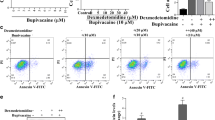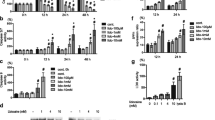Abstract
Bupivacaine is widely used for regional anesthesia, spinal anesthesia, and pain management. However, bupivacaine could cause neuronal injury. Curcumin, a low molecular weight polyphenol, has a variety of bioactivities and may exert neuroprotective effects against damage induced by some stimuli. In the present study, we tested whether curcumin could attenuate bupivacaine-induced neurotoxicity in SH-SY5Y cells. Cell injury was evaluated by examining cell viability, mitochondrial damage and apoptosis. We also investigated the levels of activation of the Akt signaling pathway and the effect of Akt inhibition by triciribine on cell injury following bupivacaine and curcumin treatment. Our findings showed that the bupivacaine treatment could induce neurotoxicity. Pretreatment of the SH-SY5Y cells with curcumin significantly attenuated bupivacaine-induced neurotoxicity. Interestingly, the curcumin treatment increased the levels of Akt phosphorylation. More significantly, the pharmacological inhibition of Akt abolished the cytoprotective effect of curcumin against bupivacaine-induced cell injury. Our data suggest that pretreating SH-SY5Y cells with curcumin provides a protective effect on bupivacaine-induced neuronal injury via activation of the Akt signaling pathway.




Similar content being viewed by others
References
Li L, Zhang QG, Lai LY, Wen XJ, Zheng T, Cheung CW, Zhou SQ, Xu SY (2013) Neuroprotective effect of ginkgolide B on bupivacaine-induced apoptosis in SH-SY5Y cells. Oxid Med Cell Longev. doi:10.1155/2013/159864
Lelkes E, Unsworth BR, Lelkes PI (2001) Reactive oxygen species, apoptosis and altered NGF-induced signaling in PC12 pheochromocytoma cells cultured in elevated glucose: an in vitro cellular model for diabetic neuropathy. Neurotox Res 3:189–203
Lu J, Xu SY, Zhang QG, Lei HY (2011) Bupivacaine induces reactive oxygen species production via activation of the AMP activated protein kinase-dependent pathway. Pharmacology 87:121–129
Arai Y, Kondo T, Tanabe K et al (2002) Enhancement of hyperthermia-induced apoptosis by local anesthetics on human histiocytic lymphoma U937 cells. J Biol Chem 277:18986–18993
Wang Z, Shen J, Wang J, Lu T, Li C, Zhang X, Liu L, Ding Z (2010) Lithium attenuats bupivacaine- induced neurotoxicity in vitro through phosphatidylinositol-3-kinase/threonineserine protein kinase B-and extracellular signal regulated kinase-dependent mechanisms. Neurotoxicology 31:101–112
Dasari VR, Veeravalli KK, Saving KL, Gujrati M, Fassett D, Klopfenstein JD, Dinh DH, Rao JS (2008) Neuroprotection by cord blood stem cells against glutamate-induced apoptosis is mediated by Akt pathway. Neurobiol Dis 32:486–498
Kim YH, Kim YS, Park CH, Chung IY, Yoo JM, Kim JG, Lee BJ, Kang SS, Cho GJ, Choi WS (2008) Protein kinase C-delta mediates neuronal apoptosis in the retinas of diabetic rats via the Akt signaling pathway. Diabetes 57:2181–2190
Ma R, Wang X, Lu C, Li C, Cheng Y, Ding G, Liu L, Ding Z (2010) Dexamethasone attenuated bupivacaine-induced neuron injury in vitro through a threonine-serine protein kinase B-dependent mechanism. Neuroscience 167:329–342
Wang X, Zhang X, Cheng Y, Li C, Zhang W, Liu L, Ding Z (2010) α-Lipoic acid prevents bupivacaine-induced neuron injury in vitro through a PI3K/Akt-dependent mechanism. Neurotoxicology 31:101–112
Nair VD, Olanow CW (2008) Differential modulation of Akt/glycogen synthase kinase-3beta pathway regulates apoptotic and cytoprotective signaling responses. J Biol Chem 283:15469–15478
Liu L, Zhang XJ, Jiang SR, Ding ZN, Ding GX, Huang J, Cheng YL (2007) Heat shock protein 27 regulates oxidative stress-induced apoptosis in cardiomyocytes: mechanisms via reactive oxygen species generation and Akt activation. Chin Med J Engl 120:2271–2277
Goel A, Aggarwal BB (2010) Curcumin the golden spice from Indian saffron, is a chemosensitizer and radiosensitizer for tumors and chemoprotector and radioprotector for normal organs. Nutr Cancer 62:919–930
Park SY, Kim HS, Cho EK, Kwon BY, Phark S, Hwang KW, Sul D (2008) Curcumin protected PC12 cells against beta-amyloid-induced toxicity through the inhibition of oxidative damage and tau hyperphosphorylation. Food Chem Toxicol 46:2881–2887
Shin HJ, Lee JY, Son E, Lee DH, Kim HJ, Kang SS, Cho GJ, Choi WS, Roh GS (2007) Curcumin attenuates the kainic acid-induced hippocampal cell death in the mice. Neurosci Lett 416:49–54
Wang R, Li YH, Xu Y, Li YB, Wu HL, Guo H et al (2010) Curcumin produces neuroprotective effects via activating brain-derived neurotrophic factor/TrkB-dependent MAPK and PI-3 K cascades in rodent cortical neurons. Prog Neuropsychopharmacol Biol Psychiatry 34:147–153
Perez-Castro R, Patel S, Garavito-Aguilar ZV, Rosenberg A, Recio-Pinto E, Zhang J, Blanck TJ, Xu F (2009) Cytotoxicity of local anesthetics in human neuronal cells. Anesth Analg 108:997–1007
Esatbeyoglu T, Huebbe P, Ernst IM, Chin D, Wagner AE, Rimbach G (2012) Curcumin—from molecule to biological function. Angew Chem Int Ed Engl 51:5308–5332
Gupta SC, Sung B, Kim JH, Prasad S, Li S, Aggarwal BB (2012) Multi targeting by turmeric, the golden spice: from kitchen to clinic. Mol Nutr Food Res 57:1510–1528
Hollborn M, Chen R, Wiedemann P, Reichenbach A, Bringmann A, Kohen L (2013) Cytotoxic Effects of Curcumin in Human Retinal Pigment Epithelial Cells. PLoS ONE 8(3):e59603. doi:10.1371/journal.pone.0059603
Hung CM, Su YH, Lin HY, Lin JN, Liu LC, Ho CT, Way TD (2012) Demethoxycurcumin modulates prostate cancer cell proliferation via AMPK-induced down-regulation of HSP70 and EGFR. J Agric Food Chem 60:8427–8434
Zamzami N, Marchetti P, Castedo M, Zanin C, Vayssiere JL, Petit PX, Kroemer G (1995) Reduction in mitochondrial potential constitutes an early irreversible step of programmed lymphocyte death in vivo. J Exp Med 181:1661–1672
Hagen TM, Moreau R, Suh JH, Visioli F (2002) Mitochondrial decay in the aging rat heart: evidence for improvement by dietary supple-mentation with acetyl-L-carnitine and/or lipoic acid. Ann N Y Acad Sci 959:491–507
Su CC, Lin YP, Cheng YJ, Huang JY, Chuang WJ, Shan YS, Yang BC (2007) Phosphatidylinositol 3-kinase/Akt activation by integrin-tumor matrix interaction suppresses Fas-mediated apoptosis in T cells. J Immunol 179:4589–4597
Chung H, Seo S, Moon M, Park S (2008) Phosphatidylinositol-3-kinase/Akt/glycogen synthase kinase-3 beta and ERK1/2 path-ways mediate protective effects of acylated and unacylated ghrelin against oxygen-glucose deprivation-induced apoptosis in primary rat cortical neuronal cells. J Endocrinol 198:511–521
Datta SR, Brunet A, Greenberg ME (1999) Cellular survival: a play in three Akts. Genes Dev 13:2905–2927
Vauzour D, Vafeiadou K, Rice-Evans C, Williams RJ, Spencer JP (2007) Activation of pro-survival Akt and ERK1/2 signalling path-ways underlie the anti-apoptotic effects of flavanones in cortical neurons. J Neurochem 103:1355–1367
Maurice JM, Gan Y, Ma FX, Chang YC, Hibner M, Huang Y (2010) Bupivacaine causes cytotoxicity in mouse C2C12 myoblast cells: involvement of ERK and Akt signaling pathways. Acta Pharmacol Sin 31:493–500
Lee HT, Xu H, Siegel CD, Krichevsky IE (2003) Local anesthetics induce human renal cell apoptosis. Am J Nephrol 23:129–139
Acknowledgments
This study was supported by Grants from the National Natural Science Foundation of China (Nos. 81471272, 81271390). None of the authors have financial relationships with biotechnology manufacturers, pharmaceutical companies, or other commercial entities with an interest in the subject matter or materials discussed in the manuscripts.
Author information
Authors and Affiliations
Corresponding author
Rights and permissions
About this article
Cite this article
Fan, YL., Li, HC., Zhao, W. et al. Curcumin Attenuated Bupivacaine-Induced Neurotoxicity in SH-SY5Y Cells Via Activation of the Akt Signaling Pathway. Neurochem Res 41, 2425–2432 (2016). https://doi.org/10.1007/s11064-016-1955-4
Received:
Revised:
Accepted:
Published:
Issue Date:
DOI: https://doi.org/10.1007/s11064-016-1955-4




